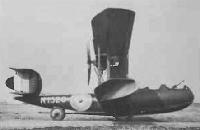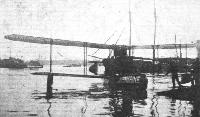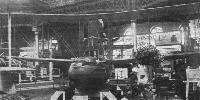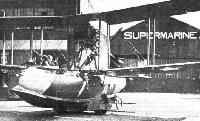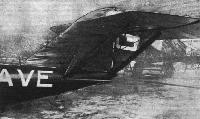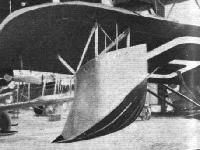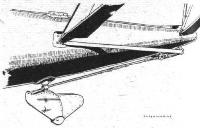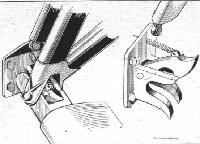
Описание
Страна : Великобритания
Год : 1916
Летающая лодка
Двухместная патрульно-разведывательная летающая лодка
A. D. Flying-Boat
Разработанная авиационным департаментом (Air Department, A. D.) британского адмиралтейства в 1915 году летающая лодка предназначалась для патрулирования и ведения воздушной разведки.
Крылья одномоторной двухместной летающей лодки могли складываться для удобства хранения самолета на корабле.
Постройка двух прототипов началась в конце 1915 года. Корпус первого прототипа изготовила фирма "Harden & Мау" в Саутгемтоне. Фюзеляж деревянной монококовой конструкции имел необычную гладкую обшивку, это был один из первых фюзеляжей, разработанных лейтенантом Литтоном Хоупом (впоследствии Хоуп стал крупнейшим британским специалистом в области проектирования летающих лодок).
Сборка первого прототипа выполнялась фирмой "Pemberton-Billing Ltd" (позже "Supermarine Aviation Work Ltd"), эта же фирма построила второй прототип и 27 серийных самолетов, которые в 1918 году объявили устаревшими.
Вскоре после окончания Первой мировой войны 19 летающих лодок было выкуплено фирмой "Supermarine" для переделки в гражданский вариант с целью последующей продажи. Модернизированные гидросамолеты получили обозначение Supermarine I в варианте с двигателем Beardmore мощностью 160 л. с, а также обозначение Channel II в варианте с мотором Siddeley Puma мощностью 240 л. с. Модернизированные самолеты были рассчитаны на одного летчика и трех пассажиров, люди размещались в трех открытых кабинах. Доработанные самолеты интенсивно эксплуатировались в Великобритании и за ее пределами. Самолеты были экспортированы на Бермудские острова, в Чили, Японию, Новую Зеландию, Норвегию, Тринидад и на Кубу.
ТАКТИКО-ТЕХНИЧЕСКИЕ ХАРАКТЕРИСТИКИ
А. D. Flying Boat
Тип: двухместная патрульно-разведывательная летающая лодка
Силовая установка: один поршневой двигатель жидкостного охлаждения Hispano Suiza мощностью 200 л. с.
Летные характеристики: максимальная скорость полета на уровне моря 161 км/ч; крейсерская скорость на высоте 3050 м 145 км/ч; практический потолок 3355 м; продолжительность полета 4 ч 30 минут
Массы: пустого 1138 кг; максимальная взлетная 1616 кг
Размеры: размах верхнего крыла 15,34; размах нижнего крыла 12,07 м; длина 9,32 м; высота 3,99 м; площадь крыльев 44,50 м:
Вооружение: один пулемет Lewis калибра 7,7 мм в задней кабине
Описание:
- A. D. Flying-Boat
- Supermarine Channel
- Flight, July 1920
The Olympia Aero Show 1920 - Flight, September 1920
THE AIR MINISTRY SEAPLANE (AMPHIBIAN) COMPETITION
Фотографии
-
Air Enthusiast 2003-01 / K.Wixey - The Bolas touch
Регистрационный номер: N1525 AD Flying-Boat N1525 of 1916, a design in which Harold Bolas was involved together with Clifford W Tinson and Harold Yendail.
-
Jane's All the World Aircraft 1980 / Encyclopedia of Aviation - Aircraft A-Z - v1
Регистрационный номер: N1520 AD flying-boat
-
Мировая Авиация 244
Летающая лодка A.D. Boat, экипаж которой включал пилота и наблюдателя, имела размах крыла 15,34 м и массу снаряженного самолета 1618 кг.
-
Aeroplane Monthly 1986-04 / J.Stroud - Wings of Peace
Регистрационный номер: N1529 Supermarine Channel-type N1529 at Southampton, almost certainly on July 23, 1919.
-
Aeroplane Monthly 1986-04 / J.Stroud - Wings of Peace
Supermarine Channel-type A. D. Flying Boat on the step.
-
Мировая Авиация 7
Летающая лодка Flying-Boat выполнена на основе превосходного корпуса, спроектированного Линтоном Хоупом. Самолет выпустили ограниченной серией, в боевых условиях летающие лодки Flying-Boat почти не применялись. После окончания Первой мировой войны самолеты были распроданы гражданским заказчикам.
SUPERMARINES IN FIJI: Last week we recorded the use of Supermarine flying boats in Fiji for surveying the coast line of the main island, Viti Levu. This is merely another instance of the way in which the Supermarine Works are hustling their products overseas, where they are now doing good work in many and varied portions of the globe. For their size and power these boats are extraordinarily seaworthy and airworthy, and one can see almost limitless possibilities for their use all round our scattered, sea-girt Empire. Our photographs show one of the Supermarine "Channel" type machines (160 h.p. Beardmore engines) taxying on the water. Note the clean wake. -
Flight 1940-04 / Flight
The machine which really laid the foundation for the greatness of the Supermarine firm was the so-called Channel Type developed from Admiralty designs. It did good work as a commercial aircraft, and was also sold abroad for Naval training purposes. It began to appear in 1919.
-
Flight 1921-11 / Flight
One of the Supermarine "Channel" type machines (160 h.p. Beardmore engines) flying.
-
Flight 1920-04 / Flight
One of the Supermarine four-seater "Channel" flying boats, the type which was tested by Gen. Sykes during his visit to the Supermarine works at Southampton last week
-
Flight 1921-04 / Flight
A SUPERMARINE TO THE RESCUE: When Miss Pearl White, the famous Cinema actress, was in Bermuda, she missed the steamer that was to carry her home to New York by five hours. However, the Bermuda and West Atlantic Aviation Co., Ltd., placed a Supermarine Channel-type flying-boat at her service, and the steamer was overtaken, and Miss White taken on board. Our photographs - altogether a real smart piece of work show (1) the steamer seen from the Supermarine, (2) the boat putting off from the steamer, (3) Miss White waving good-bye to the pilot of the Supermarine.
-
Flight 1922-11 / Flight
SUPERMARINES IN JAPAN: 4. A "Channel type" training machine with Siddeley "Puma" on the slipway. 5. The machine on the water.
-
Flight 1920-07 / Flight
At Olympia: The Supermarine Channel Type flying boat
-
Air Pictorial 1958-10
MARK TWO CHANNEL; Responding to our pleas for rare photographs, Swedish industrial designer Bjorn Karlstrom of Bromma has submitted this hitherto unpublished photograph of the one and only Supermarine Channel Mk. II which was supplied to the Royal Swedish Navy ca. 1919. Herr Karlstrom says that the Channel II was well thought of and regarded as "the most beautiful craft of its day". Unfortunately, it crashed at Fjaderholmarna, near Stockholm, killing the pilot. The Mk. II was powered by a 240-h.p. Siddeley Puma (Mk. I: 160-h.p. Beardmore), and was a post-war development of the Admiralty Air Dept. A.D. Flying-Boat of 1915, built by Pemberton-Billing Ltd., which later became Supermarine Aviation Works Ltd. of Southampton.
-
Flight 1920-05 / Flight
SUPERMARINES FOR NORWAY: Our photographs show two of the batch of Supermarine flying boats ordered by the Royal Norwegian Navy. The machine on the left is fitted as a three-seater with special dual control, and will be used as a school machine at the Norwegian naval seaplane base at Horten. The machine shown on the right is of the standard four-seater Channel type, which has proved so successful. Fitted with a Beardmore engine of 160 h.p. only, this machine gets off and alights well with four up, which is no mean performance. The inset shows one of the machines moored to a buoy after completing its trial flights. It is interesting to know that when a complete squadron of these boats has been delivered, they will be used on behalf of the Norwegian Government in conjunction with a private civil aviation enterprise to carry out passenger and mail service between Christiania and Christiansand. A number of officers of the Norwegian Naval Air Service have been given a course of instruction on the Supermarine flying boats. They are all experienced seaplane pilots, and are now fully qualified flying boat pilots
-
Flight 1921-02 / Flight
A Supermarine flying - boat, belonging to the Norske Luftfartrederi, outside Bergen, Norway.
-
Flight 1921-02 / Flight
SUPERMARINES IN NORWAY: The photograph on the left shows one of the Supermarine boats used by the Norske Luftfartrederi, and on the right is a view of Stavanger taken from the Supermarine boat.
-
Flight 1922-11 / Flight
SUPERMARINES IN CHILE: A "Channel type, Mark II," with 230 h.p. Siddeley "Puma" engine. Inset, the machine taxying. Note the "cleanness" of the machine after having its front step re-designed.
-
Flight 1924-05 / Flight
The Supermarine naval training school machine is a three-seater.
-
Flight 1921-03 / Flight
One of the two Supermarine flying boats which are being sent on an oil-prospecting expedition to South America.
-
Flight 1921-03 / Flight
The Supermarine oil-prospector: This view shows the special camera-manhole in the bottom of the hull near the bows.
-
Flight 1920-09 / Flight
Регистрационный номер: G-EAVE [5] THE AIR MINISTRY COMPETITION: Wheeling out the Supermarine Amphibian flying-boat, 360 h.p. Rolls-Royce "Eagle" engine
-
Flight 1940-04 / Flight
Регистрационный номер: G-EAVE [5] The Seagull, Mark I, amphibian making a landing test on rough ground in the Air Ministry competitions of 1921.
-
Flight 1920-09 / Flight
Регистрационный номер: G-EAVE [5] TESTING THE SUPERMARINE AMPHIBIAN AT MARTLESHAM: Starting off and, inset, coming in
-
Flight 1920-09 / Flight
Регистрационный номер: G-EAVE [5] The Supermarine Amphibian: View of the tail planes
-
Flight 1920-09 / Flight
Регистрационный номер: G-EAVE [5] THE SUPERMARINE AMPHIBIAN: One of the wing tip floats
-
Flight 1920-07 / Flight
ON THE SUPERMARINE CHANNEL TYPE: Left, the ingenious boat-hook, and, right, the neat way in which the anchor rope is coiled up on the outside of the hull, thus avoiding getting the cockpit wet and muddy
-
Flight 1920-07 / Flight
THE BIPLANE TAIL OF THE SUPERMARINE CHANNEL-TYPE FLYING BOAT: In the Sketch on the left the control cables have been omitted for the sake of clearness. The sketch on the right shows the manner of interconnecting the water-rudder and air-rudders. Here the bracing wires have been omitted
-
Flight 1920-07 / Flight
SOME SUPERMARINE DETAILS: The wing tip float on the Channel type.
-
Flight 1920-09 / Flight
The water rudder of the Supermarine is sprung by cables and shock-absorbers to the stern
-
Flight 1920-09 / Flight
ON THE SUPERMARINE: Details of the locking arrangement of the land gear
- Фотографии

